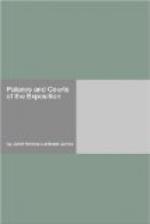They have brought the waters of the far Sierras and turned these waters into living light that put new stars in the heavens at night. They have hung their sky-line with a garden of flowers; they have worked a magic. They have gathered here in all these temples to tell their victory — the pioneers — what they have done and in what manner. This city has been finished in blue and gold, in scarlet and purples and the greens of the sea, and burnt brown, and the scene shown the pioneer has made the architecture of the centuries to march before their eyes in columns and colonnades.
The long journey of this light figure of the pioneer is at an end, the waste places of the earth have been found and filled, but adventure is not at an end; the greatest adventure is before us, the gigantic adventures of an advancing democracy — strong, virile and kindly — and in that advance we shall be true to the indestructible spirit of the American pioneer.
The Italian Towers
Architect — Geo. Kelham of San Francisco.
Architecture — Italian Renaissance with Byzantine touches. (See picture facing page 22.)
These very beautiful towers are seen in pairs on either side The Court of Flowers and The Court of Palms, and assist in the fine balance preserved thruout the block of palaces.
They are not alike, as you will see when you examine them. The pair flanking The Court of Flowers is far simpler, and produces quite a different effect, when illuminated, from its sister towers.
The vibrant red that seems to give throbbing life to these beautiful towers is one of the chief glories of the night-glow.
The entrances at the base of the tower are accented by magnificent Siena marble columns, and the coloring from these entrances to the top of the towers is most unique.
The long rectangular height is admirably treated with a most original diaper design.
Jules Guerin, the colorist, has used small areas of color on the towers to play upon the color of the courts below.
For instance, note the pastel-pink walls, the greatest color area of the courts reflected, as it were, upon the largest colored area of the towers; the travertine of the courts acting as a background for the towers, the burnt orange capitals shown in the use of the same color on the tower, the Indian red appearing through the design as it appears on the capitals.
The result is a sort of dissonance that makes the harmony of the courts more charming than ever.
The most adroit management of the blue-checkered border is seen. It is the means of drawing your colored diaper work toward that blue background, the sky, and is superb in its connecting force.
The little towers above, with the turquoise-blue columns, show a most daring use of color when you consider the colors below, but how admirably that turquoise blue works onto the domes and the blue columns of The Tower of Jewels.




